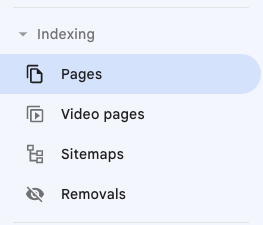How to Get Google to Index Your Website: Effective Strategies Explained

Getting your website indexed by Google is a crucial step in making your content visible and accessible to a wider audience. When your site is indexed, it means that Google has crawled and stored information about it, making it easier for users to find your site through search engine results. Understanding the process and implementing the right strategies can significantly improve your website’s visibility and, in turn, boost your website traffic.
To begin with, you should ensure that your website is well-structured, with relevant and high-quality content. This will not only make it easier for Google to index your site but will also be beneficial for your users. Implementing search engine optimization (SEO) techniques can make a substantial difference in your website’s discoverability, as these methods focus on improving your content and website structure to align with Google’s algorithms.
Another effective way to get your website indexed by Google is by utilizing various tools and platforms that facilitate this process. These resources can help you submit your website to Google, monitor its indexing status, and identify potential issues. By following these guidelines and using the right tools, you can ensure that your website reaches its target audience and achieves better visibility on search engines.
Understanding Google Indexing
Contents
Google indexing is the process by which Google’s search engine algorithm crawls and stores web pages for later retrieval when a user searches for specific keywords related to the content of the page. To ensure that your website is indexed by Google, it is crucial to understand the basic principles of how this process works.
The Google index is a massive database that stores copies of web pages from all around the world. When a user searches for a term or phrase, the search engine algorithm looks through the index to find the pages that best match the query. The results are displayed on the search engine results page (SERP), ranked according to their relevance and authority on the subject matter.
Google’s indexing process is carried out by automated bots called Googlebot. These bots follow links from one web page to another, discovering and storing new content in the index. The crawling frequency and speed may vary depending on several factors, such as the authority of the website and whether or not the content is updated regularly. Newly-registered domains or websites with low authority may experience longer waiting periods between crawls.
There are several best practices that webmasters can apply to improve their website’s indexing by Google:
- Submit a sitemap: A sitemap is an XML file that lists all the web pages of a website, allowing search engines to understand its structure. Submitting a sitemap via Google Search Console can facilitate the indexing process.
- Optimize internal links: Ensuring that web pages within the website are well-connected through internal links enables Googlebot to crawl and index the content more efficiently. Use Beki AI to find opportunities and create internal links in the matter of seconds.
- Create high-quality, unique content: Publishing valuable and engaging content helps improve the website’s authority and increases the likelihood of other websites linking to it. This, in turn, leads to more frequent crawls and indexing by Googlebot.
- Utilize header tags: Properly structuring your content with appropriate heading tags (e.g., H1, H2, H3) makes it more readable and accessible for Googlebot, which helps improve indexing.
It is essential to monitor your website’s indexing performance using tools such as Google Search Console. This platform offers insights into how many of your web pages have been indexed, errors encountered during the crawling process, and recommendations for improvement. By understanding and implementing these practices, you can increase the chances of your website being indexed quickly and accurately by Google, ultimately increasing its visibility in search results.
Setting up Your Website for Indexing
To ensure that Google indexes your website effectively, it is essential to set up your site properly. This involves optimizing your robots.txt file and utilizing sitemaps to guide search engine crawlers.
Optimizing Robots.Txt File
The robots.txt file plays a vital role in providing instructions to web crawlers about which parts of your website should be accessed and indexed. Make sure you create a robots.txt file at the root directory of your site, and use clear syntax to guide crawlers. Keep in mind the following suggestions:
- Allow all: Use the “User-agent: *” directive to apply the rules to all search engine crawlers.
- Disallow specific pages: If you want to prevent certain pages from being indexed, use the “Disallow: /page-path” directive.
- Crawl-delay: To avoid overloading your server, you can set a crawl-delay (in seconds) using the “Crawl-delay: X” directive.
It’s also a good idea to use Google’s URL Inspection Tool to check your existing robots.txt file for errors.
Utilizing Sitemaps
A sitemap is a critical component for guiding search engine crawlers to discover and index your website’s content. To create a sitemap, consider the following steps:
- Choose a format: XML is the most common format for sitemaps, but other formats like RSS and Atom are also supported by Google.
- List your URLs: Include all the relevant URLs of your website, with priority given to the most important pages.
- Keep it up to date: Update your sitemap whenever you add or remove pages, and submit it to Google Search Console.
- Refer to your sitemap: Mention your sitemap’s location in the
robots.txtfile using the “Sitemap: ” directive, e.g., “Sitemap: http://www.example.com/sitemap.xml“
Google relies on your sitemap to understand your website structure and provide detailed information about your pages. This greatly enhances the likelihood of your site appearing in search results. By following these steps and optimizing your website for indexing, you will improve your site’s visibility and ranking in search engine results.
Creating a Search Engine-Friendly Website Content
To ensure that your website gets indexed by Google, it is crucial to focus on creating search engine-friendly content. This involves crafting quality content that is valuable to your readers and enhances the overall user experience.
A great starting point is conducting thorough keyword research using tools like the Content Explorer. This will help you discover relevant topics and keywords that your target audience is searching for. Incorporating these keywords naturally into your content will boost its visibility in search results.
High-quality content is not only engaging but also informative. Avoid creating low-quality pages that add little value to your readers, as these can negatively impact your website’s reputation. Instead, aim to offer valuable insights with actionable tips and useful information, while ensuring that the content is well-structured and easy to read.
In addition, consider incorporating visual elements, such as images, videos, and infographics, to support your written content. This can improve user engagement and help convey complex information more effectively. Remember to appropriately optimize these visual elements with descriptive alt text and captions that contain relevant keywords.
Enhance readability by using:
- Short paragraphs
- Subheadings
- Bullet points
- Bold text for emphasis
Moreover, regularly update your content by adding new information, addressing user feedback, and fixing any errors. This not only keeps your content fresh but also demonstrates your commitment to providing the best possible user experience.
Lastly, don’t forget to promote your content through various online channels, such as social media, email marketing, and content syndication. This paves the way for more potential visitors to find and engage with your valuable content, ultimately leading to better chances of getting your website indexed by Google.
Using Google Tools to Aid Indexing
Google Search Console
Google Search Console is a valuable tool for website owners that want to ensure their webpages get indexed by Google. It provides insights into how Google views a site and offers suggestions for improvements. To get started, verify ownership of the website in the console. Once verified, submit an XML sitemap to help Google’s crawlers discover all essential pages.
Monitor the “Coverage” report in Google Search Console to identify potential issues with indexing. This report provides information on:
- Pages that were successfully indexed
- Pages with errors or warnings
- Pages excluded by Google
Rectify any detected issues and request indexing for specific pages as needed. Also, monitor the “Performance” report to see which search queries lead to the website and adjust content accordingly to maximize relevance.
Google Analytics
While Google Analytics might not directly impact a site’s indexing, it can provide valuable insights into user behavior and site performance. By analyzing these metrics, improvements can be made to better match user intent and adhere to Google’s guidelines.
Start by connecting Google Analytics to the website and monitor the following metrics:
- Bounce rate: High bounce rates may indicate irrelevant content or a poor user experience. Optimize pages accordingly to keep users engaged.
- Average time on page: Aim for longer session durations. This can be achieved by improving content quality and interlinking relevant articles.
- Organic traffic: Monitor the growth of organic traffic over time. If it stalls or declines, investigate potential issues with indexing or content quality.
By using Google Search Console and Google Analytics effectively, website owners can identify opportunities for improvement and take the necessary steps to ensure their website gets indexed by Google. With these tools, optimizing and monitoring the site becomes a manageable task that, over time, leads to improved discoverability and visibility in Google’s index.
Avoiding Common Issues and Checking Indexed Pages
To ensure that Google indexes your website effectively, it is crucial to address common problems and verify the number of indexed pages. One of the first steps you can take is to check your website’s internal links. Ensuring proper internal linking helps Google’s web crawlers to navigate your site more easily. Make sure to update or remove any broken links to avoid negatively impacting your site’s indexing process.
Another issue to be aware of is duplicate content. Duplicate content can confuse search engines and may lead to lower rankings or penalties. To resolve this, implement canonical tags on your website pages. These tags indicate to search engines which version of a page should be considered as the primary one, helping them to consolidate duplicate content and index your site accurately.
The use of meta tags is also essential for better indexing. Specifically, the meta description tag provides a brief summary of your page’s content, while the meta robots tag gives directives to search engines on how to crawl and index your site. Make sure these tags are present, accurate, and up to date for better indexing.
When using external links on your website, it’s important to use nofollow tags where appropriate. Nofollow tags tell search engines not to follow certain links or give them ranking power. They are especially useful when linking to potentially unreliable sources or user-generated content, preventing search engines from associating your site with low-quality content.
Security issues can also hinder the indexing process. Google prioritizes secure websites, so be sure to address any security issues promptly. Implement HTTPS for encrypted data transfer, update software regularly, and follow security best practices to maintain a safe and secure website.
Finally, to check how many of your website’s pages have been indexed by Google, use the “site:” search operator followed by your domain. For example: site:example.com. This will show you the indexed pages and help you identify any outstanding issues that may affect your website’s visibility in search results.

